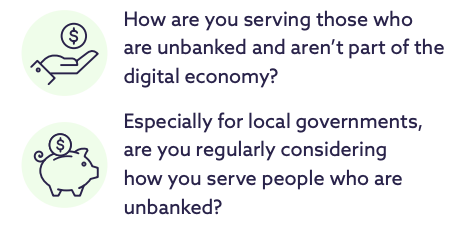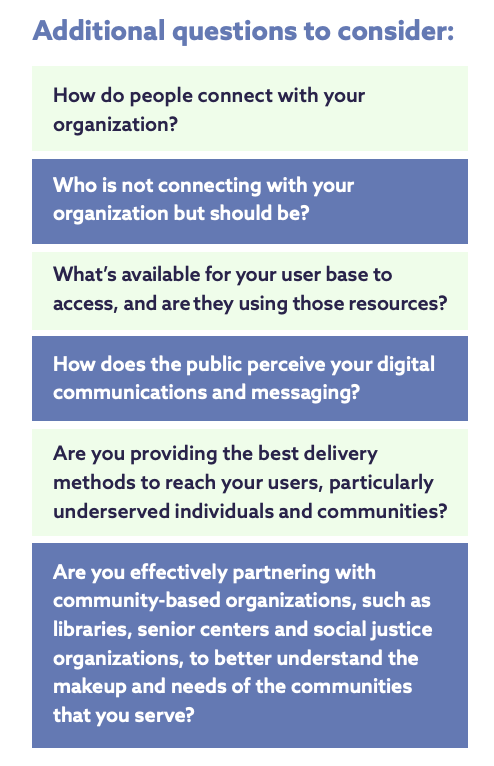Editor’s note: This article is an excerpt from GovLoop’s recent report, “Delivering Government Services Through a Lens of Equity: Technology, Policies and Conversation Starters.” Download the full report here for a breakdown of the equity impact review process and additional insights.
There are efforts underway to assess equity across government services and programs. And, yes, this might feel like novel work to some. But for others, equity is hardwired into how they think, work and serve communities.
“All of our work is about people,” said Tanya Hannah, Chief Information Officer for King County, Washington. You won’t hear her talking cloud or any other technology business model without including people and how their lives are impacted. And she backs up her talk with action.
The county’s Equity Impact Review (EIR) Tool is actually a process and a tool to “identify, evaluate, and communicate the potential impact — both positive and negative — of a policy or program on equity.” The goal is to help departments and agencies increase equity and social justice work in the community and within the services King County government provides.
Since at least 2018, Hannah’s team has been conducting EIRs of technology initiatives, which is now standard practice for all IT projects regardless of size. This shift was born out of necessity, not compliance. There was a need and desire to better understand internal and external customers and how technology decisions affect their lives.
We asked Hannah to share some takeaways from the EIRs:
• Before implementing a new technology, understand the motivations for people to connect with your organization or service. • Understand what they need to engage with you.
• Focus on the customer experience of those you serve.
• Not all technology is created equally. Know the difference when it comes to quality and what experience you’re trying to create for customers.
When it comes to using cloud technologies, in particular, leading with people first means viewing cloud (your how) as an opportunity to be nimbler and reach more people (your why). She’s especially concerned about school-age children and adults who have become increasingly disconnected because of the pandemic.
“Tech is there to make it easier, to help eliminate barriers,” Hannah said. With the rise of more internet-connected devices, though, comes the increasing threat of security risks. That must all be factored in as technologists collaborate across departments and rethink what service delivery looks like today and in a post-pandemic world.
Conducting Equity Impact Reviews: Perception vs. Reality
One of the valuable lessons that Hannah has learned from conducting EIRs is that what’s perceived as modern, helpful and intuitive internally might not be viewed that way by the very people that tech solutions are meant to help.
For example, as part of the county’s process to modernize its property tax system, there’s a public-facing component that allows seniors to go online and see if they qualify to claim certain tax exemptions based on age, income, disability status and other factors. The goal is to help seniors stay in their homes despite rising property values and taxes. As part of the EIR, Hannah’s team ran usability tests and gleaned feedback from potential users by partnering with AARP and senior centers.
Learning moment
“We had individuals from 55 up to 95 years old providing feedback,” Hannah said. “Things that we thought were cutting-edge, simplistic, they were like, ‘Why do I have to answer your questions to see if I qualify? Why don’t you just tell me?’” Simply put, users generally wanted to know the qualifications upfront, rather than having to enter personal information to verify if they qualified.
“We had to go back and redesign,” she said. The technology didn’t impress users. They wanted an experience they found easy to use and understand.
Conducting internal reviews
Hannah also sees value in conducting EIRs on internal technology rollouts. The reasons:
• Technology changes affect employees, and their input is valuable.
• EIRs can support change management efforts, including training and communications with staff.
• Understanding your employee community is equally important as understanding the business community and the wider public that you serve.
“If you don’t understand who you’re serving [and] what their needs are, you may take for granted or overlook certain aspects that communities may find important,” she said.
Learning moment
The voice and perspectives of customers are critical, and learning how to view the world through their eyes is what brings equity to life. As a Black woman in tech, Hannah’s life experiences shape her work in rich ways and guide how she shows up for diverse communities, what questions she asks, and how she listens and responds with empathy.
And as someone who wears glasses and has spent considerably more time in front of a screen since the pandemic, she’s keenly aware of how government websites are presented digitally. There are people on her team, for example, who use screen readers or text-to-speech tools, to review websites and digital content for accessibility. The pandemic has reaffirmed the urgency of her team’s work to revamp the county’s online presence. The focus is making websites easier to navigate so that residents can find what they need when they need it.
Before you rush to digitize…
Hannah shared some considerations to make as you keep equity at the forefront while also embracing new technologies and capabilities. She’s especially passionate about government serving constituents who are unbanked or underbanked. They either do not use banks or banking institutions, or they typically use cash, money orders or prepaid debit cards for transactions.

It’s one thing to make decisions based on what you know and understand about the people accessing your services. But what about the people who are hesitant, unsure or unable to connect with your agency using current methods? 





Leave a Reply
You must be logged in to post a comment.